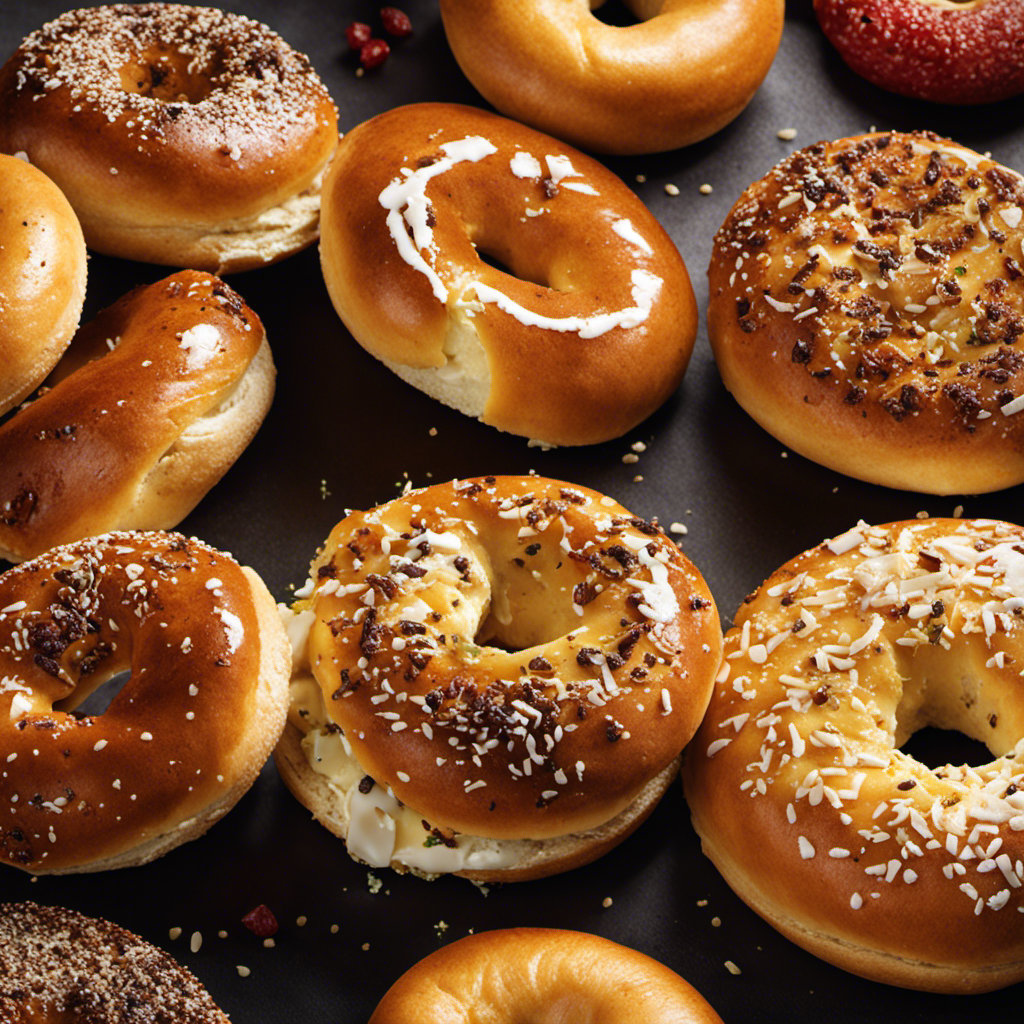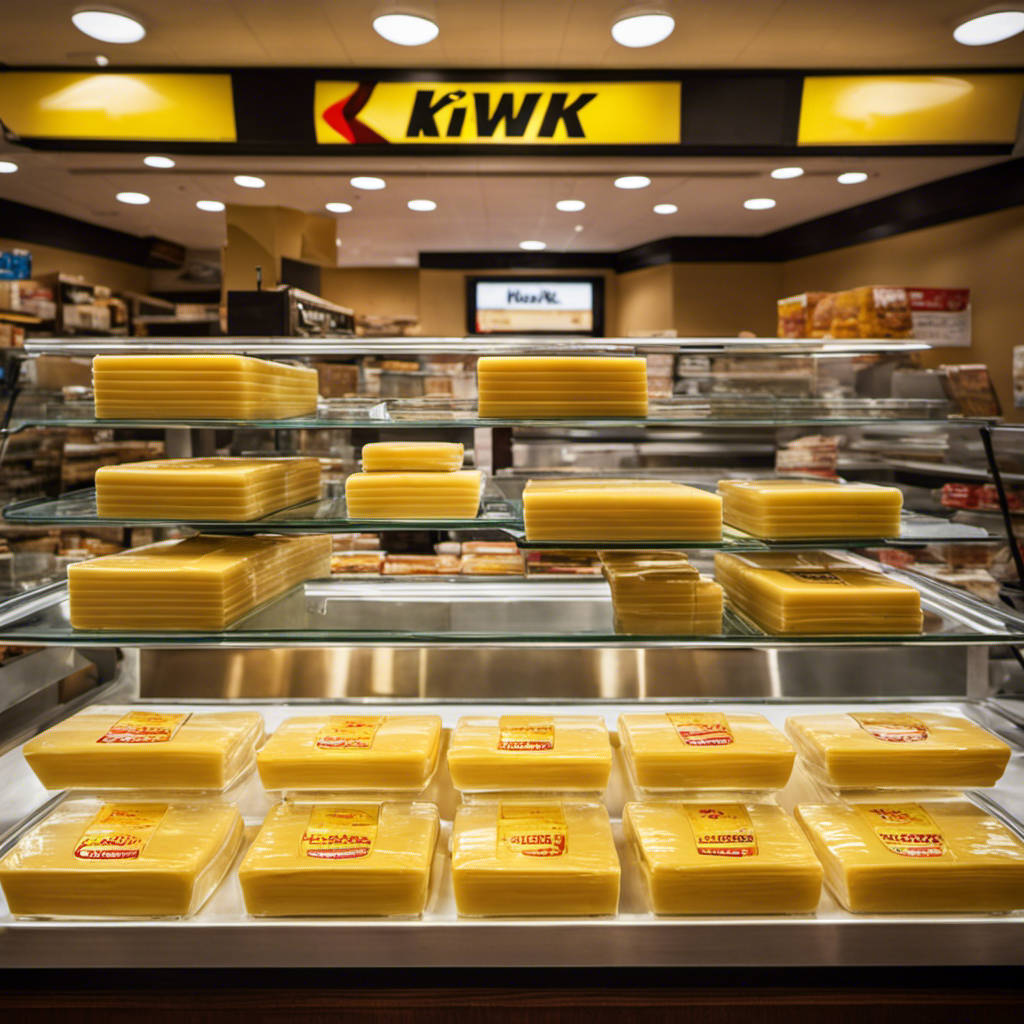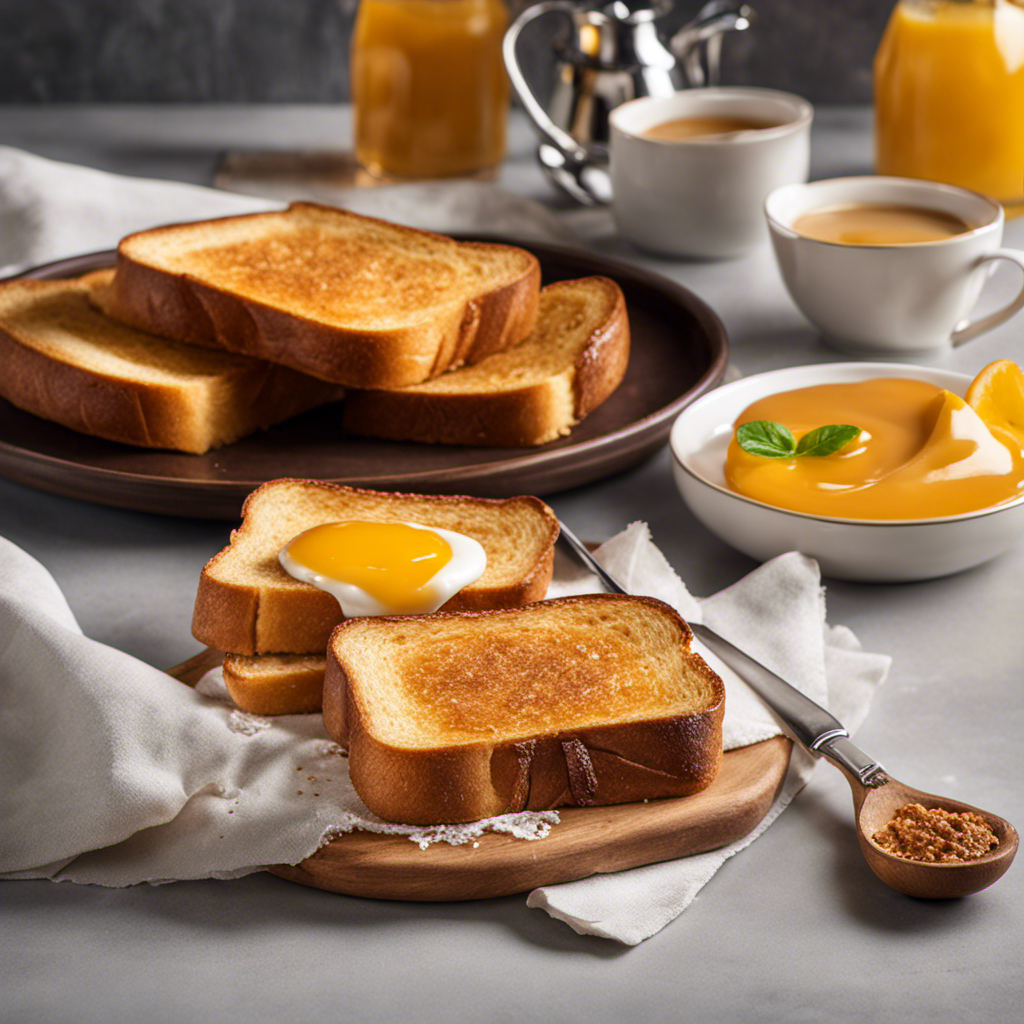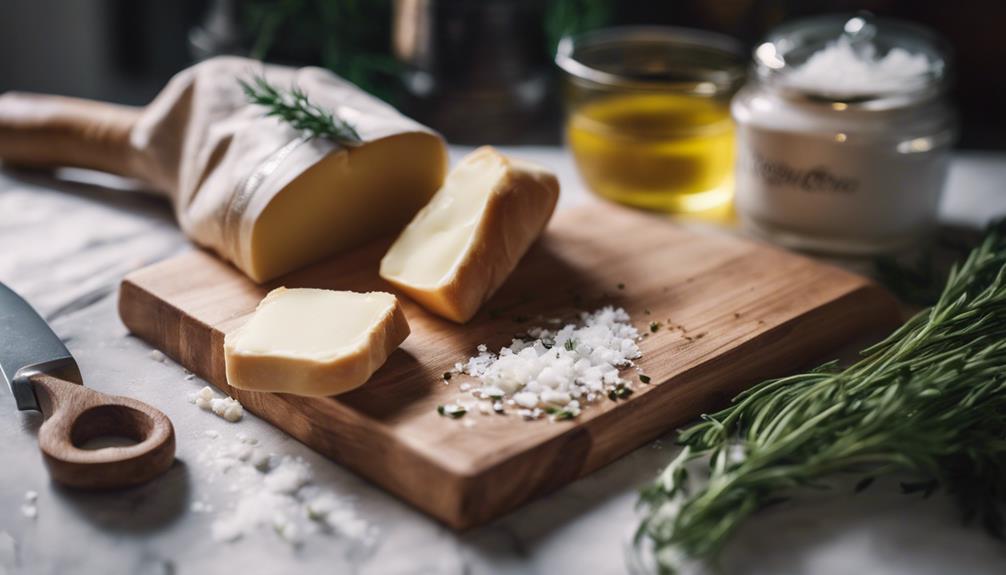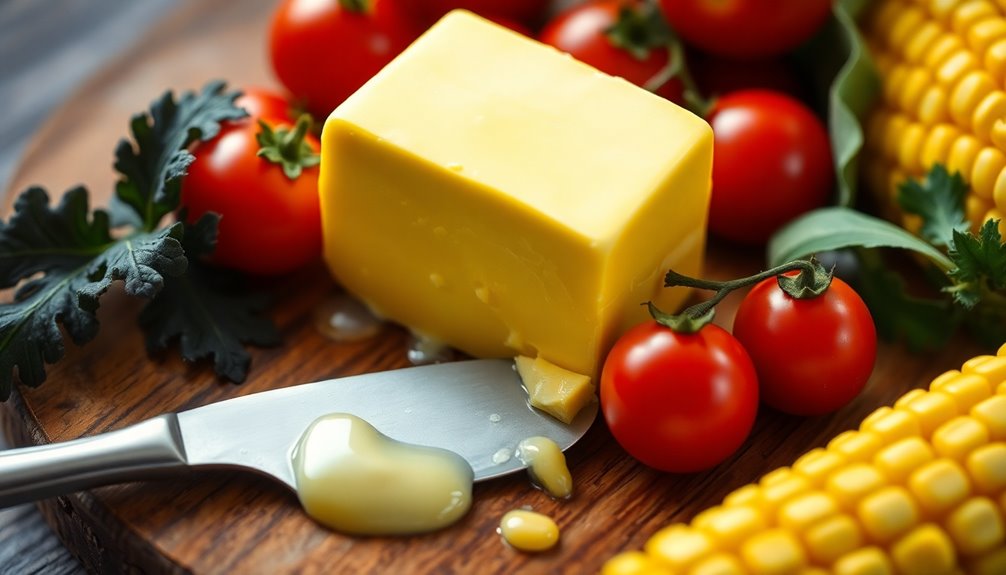I can’t speak for everyone, but personally, when it comes to bagels slathered in butter, my taste buds go wild. However, have you ever thought about the calorie content in that delicious combination?
Well, wonder no more! In this article, I’ll be diving into the world of bagels with butter, exploring the calorie content, portion sizes, and even healthier alternatives.
So, grab a cup of coffee and get ready to satisfy your curiosity while keeping your waistline in check.
Key Takeaways
- Bagels with butter typically contain 300-400 calories.
- Adding 1 tbsp of butter increases calorie content by about 55 calories.
- Choosing reduced-fat or light butter options decreases calorie content.
- Whole wheat bagels are a healthier alternative to white bagels.
Bagel Nutrition Basics
A bagel with butter typically contains around 300-400 calories.
It’s important to understand the nutritional value of a bagel with butter in relation to overall dietary needs and health considerations.
Bagels come in a variety of flavors, from plain to everything bagels, offering different taste options. When exploring bagel flavors, it’s crucial to also consider their nutrition content.
While bagels can be a tasty breakfast choice, they are relatively high in calories due to their carbohydrate content. It’s important to be mindful of portion sizes and balance them with other nutrient-rich foods.
Understanding bagel nutrition can help individuals make informed choices about their overall diet.
Next, let’s dive deeper into understanding calorie content and its impact on our health.
Understanding Calorie Content
To understand the calorie content of a bagel with butter, it’s important to be mindful of the nutritional information. Here are some key points to consider:
-
Portion sizes vary: The calorie content of a bagel with butter can differ depending on the size of the bagel and the amount of butter used.
-
Bagel toppings matter: Some bagel toppings, like cream cheese or avocado, can add additional calories and nutrients.
-
Calorie breakdown: On average, a medium-sized plain bagel contains around 280-350 calories, while a tablespoon of butter adds about 100 calories.
-
Healthier alternatives: If you’re looking for a healthier choice, consider using light or reduced-fat butter spreads, or opting for toppings like nut butter or fresh fruit.
Understanding portion sizes and making mindful choices about bagel toppings can help manage calorie intake.
Now, let’s explore the impact of butter on calories and overall nutritional value.
The Impact of Butter on Calories
Butter can significantly increase the calorie content of a bagel. Adding butter to your bagel can add extra flavor, but it also adds extra calories. Let’s take a closer look at the impact of butter on the calorie content of a bagel.
Here is a table showing the approximate calorie content of different types of bagels with butter:
| Type of Bagel | Calories (without butter) | Calories (with 1 tbsp butter) |
|---|---|---|
| Plain | 245 | 300 |
| Whole Wheat | 245 | 300 |
| Cinnamon Raisin | 275 | 330 |
As you can see, adding just one tablespoon of butter to your bagel can increase the calorie content by about 55 calories. This may not seem like much, but it can add up if you’re watching your calorie intake.
If you’re looking for a lower calorie option, there are butter alternatives available. Some popular alternatives include nut butters, such as almond or peanut butter, or even avocado. These options can provide a similar creamy texture and added flavor without the high calorie content.
Analyzing Bagel and Butter Portions
When comparing the calorie content of a bagel with butter to other options, it’s important to consider serving size recommendations.
A registered dietitian or nutritionist would provide informative content about the nutritional value of a bagel with butter. They would discuss the calorie content in relation to overall dietary needs and health considerations.
They might also include information about the macronutrient composition, potential health benefits or risks, and alternative options for a healthier choice.
Calorie Content Comparison
The calorie content of a bagel with butter is higher than that of a plain bagel. When comparing the nutritional value of bagels to other breads, it’s important to consider the calorie differences.
Here is a breakdown to help you understand:
-
Bagel with butter: A medium-sized bagel with butter can contain around 300-400 calories, depending on the size and type of bagel.
-
Plain bagel: On its own, a plain bagel typically contains around 250-300 calories. This is still a significant amount, but lower than when butter is added.
-
Bagel vs. croissant: Comparatively, a croissant tends to have fewer calories than a bagel, with an average of 200-250 calories. However, it’s important to note that croissants often have higher amounts of unhealthy saturated fats.
-
Healthier options: If you’re looking for a lower-calorie alternative, consider whole grain breads or wraps, which typically have fewer calories and provide more fiber and nutrients.
Serving Size Recommendations
When it comes to bagels with butter, portion control is key. To help you make informed choices, here are some serving size recommendations and portion control tips:
| Serving Size | Calories | Portion Control Tips |
|---|---|---|
| 1 small bagel with butter | 250 calories | – Opt for smaller bagels to reduce calorie intake. – Spread a thin layer of butter to limit added fat and calories. |
| 1 medium bagel with butter | 320 calories | – Consider sharing a bagel with someone to cut down on portion size. – Use a measuring spoon to ensure you’re using the recommended amount of butter. |
| 1 large bagel with butter | 400 calories | – Enjoy half of the bagel and save the rest for later. – Choose a reduced-fat or light butter option to decrease calorie content. |
Calorie Breakdown for Plain Bagel With Butter
When considering the calorie breakdown of a plain bagel with butter, it’s important to discuss the contributions of both the butter and the bagel itself.
Butter is a high-calorie food, with approximately 102 calories per tablespoon. Meanwhile, a plain bagel typically contains around 245 calories. Therefore, when enjoying a bagel with butter, the overall calorie count can quickly add up.
Butter’s Calorie Contribution
You’ll want to be mindful of how much butter you spread on your bagel because it adds a significant number of calories. Here’s a breakdown of the calorie content in a bagel with butter:
-
Butter’s nutritional value: Butter is primarily composed of fat and contains no significant vitamins or minerals. It does provide small amounts of vitamin A and vitamin D.
-
Calorie contribution: One tablespoon of butter adds about 100 calories to your bagel. This can quickly add up if you use multiple tablespoons.
-
Effect on cholesterol levels: Butter is high in saturated fat, which can raise your LDL (bad) cholesterol levels when consumed in excess. High LDL cholesterol is a risk factor for heart disease.
-
Health considerations: It’s important to consider your overall dietary needs and health goals. If you’re watching your calorie intake or have high cholesterol, opting for a lighter spread or alternative like avocado or nut butter may be a healthier choice.
Bagel’s Caloric Content
The caloric content of a bagel can vary depending on its size and ingredients. A standard plain bagel typically contains around 245 calories. Adding butter to a bagel can significantly increase its calorie content. One tablespoon of butter adds approximately 102 calories. Therefore, a bagel with butter can range from 347 to 447 calories, depending on the size and amount of butter used.
It’s important to consider portion sizes when consuming bagels with toppings. Opting for a smaller bagel or using less butter can help reduce calorie intake. Additionally, individuals with specific dietary needs or health considerations should be mindful of their overall calorie intake and choose alternative options for a healthier choice, such as spreading avocado or low-fat cream cheese on their bagel.
Overall Calorie Count
To get an idea of the overall calorie count, it’s helpful to consider the size and ingredients of the bagel you’re consuming. Here are some key points to consider when it comes to calorie counting and portion sizes for a bagel with butter:
-
Bagel size: The size of the bagel can greatly impact its calorie content. Larger bagels tend to have more calories than smaller ones.
-
Ingredients: The type and amount of butter you use will also affect the calorie count. Opting for a lighter spread or using less butter can help reduce calories.
-
Bagel variations: Different types of bagels, such as whole wheat or multigrain, may have varying calorie levels. It’s important to check the nutrition label or consult a registered dietitian for accurate information.
-
Balancing your diet: While a bagel with butter can be enjoyed as part of a balanced diet, it’s essential to consider your overall calorie intake and portion sizes to meet your dietary needs.
By understanding the calorie content and portion sizes of a bagel with butter, you can make informed choices about your meals.
Now, let’s explore different bagel varieties and their nutritional profiles.
Exploring Different Bagel Varieties
There are various bagel varieties available, each with its own unique flavor and texture.
When it comes to whole wheat bagel options, they provide a healthier alternative compared to traditional white bagels. Whole wheat bagels are made from whole grain flour, which contains more fiber, vitamins, and minerals. These nutrients can help support a balanced diet and promote good health.
However, it’s important to note that adding butter to a bagel can significantly increase its calorie content. A typical bagel with butter can range from 300 to 400 calories, depending on the size and type of bagel. While butter adds flavor, it’s also high in saturated fat, which should be consumed in moderation.
For a healthier choice, consider swapping butter for a spread like avocado or nut butter, which provide healthier fats and additional nutrients.
Comparing Butter Brands and Calories
If you’re trying to keep your calorie intake in check, it’s worth comparing different brands of butter. Here is a comparison of nutritional values for four popular butter brands:
- Brand A: 100 calories per tablespoon
- Brand B: 80 calories per tablespoon
- Brand C: 90 calories per tablespoon
- Brand D: 110 calories per tablespoon
When it comes to health benefits, butter is a source of fat-soluble vitamins like vitamin A and E. However, it is also high in saturated fat, which can increase the risk of heart disease when consumed in excess. Considering this, it is important to use butter in moderation and opt for healthier alternatives when possible, like avocado or nut butter spreads.
Ultimately, the choice of butter brand depends on individual preferences and dietary goals. Remember to read the nutrition labels and compare the calorie content to make an informed decision.
Tips for Lighter Bagel and Butter Options
When it comes to enjoying a bagel with butter, there are some key points to keep in mind for a healthier option.
First, consider choosing healthier spread alternatives that are lower in saturated fats and calories.
Additionally, practicing portion control is crucial to maintain a balanced diet.
Lastly, opting for whole grain bagels can provide additional fiber and nutrients.
Healthier Spread Alternatives
You should consider trying healthier spread alternatives instead of butter on your bagel to reduce calorie intake. Here are some low calorie bagel toppings that can still add flavor and satisfaction to your breakfast:
-
Avocado: Mash up some ripe avocado and spread it on your bagel for a creamy and nutritious option. Avocado is packed with heart-healthy fats and provides essential vitamins and minerals.
-
Hummus: Opt for a savory twist by spreading hummus on your bagel. Hummus is made from chickpeas, which are high in fiber and protein. It adds a delicious Mediterranean flavor to your morning meal.
-
Greek yogurt: Swap butter for Greek yogurt to add a tangy and protein-rich topping. Greek yogurt is low in calories and provides a creamy texture. You can also mix in some herbs or spices for an extra kick.
-
Nut butter: Choose natural nut butter, like almond or peanut butter, to add a nutty and satisfying taste to your bagel. These spreads are rich in healthy fats, protein, and fiber.
By exploring these healthier spread options, you can enjoy your bagel guilt-free while still satisfying your taste buds.
Now let’s move on to some portion control tips.
Portion Control Tips
When it comes to enjoying a bagel with butter, portion control is key. It’s important to be mindful of the calorie content and make choices that align with your overall dietary needs and health goals. Here are some portion control tips to keep in mind:
-
Size Matters: Opt for smaller bagels rather than oversized ones. A smaller bagel means fewer calories.
-
Spread Sparingly: Instead of slathering on a thick layer of butter, use a conservative amount. This will help reduce the overall calorie content.
-
Pair with Protein: Consider adding a source of lean protein, like smoked salmon or a boiled egg, to your bagel. This will help increase satiety and balance out the meal.
Choosing Whole Grain Bagels
Opt for whole grain bagels instead, as they provide more fiber and nutrients compared to other options. Here are four reasons why whole grain bagels are a healthier choice:
-
Higher fiber content: Whole grain bagels contain more fiber than their refined counterparts, promoting better digestion and helping to keep you fuller for longer.
-
More vitamins and minerals: Whole grain bagels are packed with essential nutrients like B vitamins, iron, and magnesium, which are important for overall health and energy production.
-
Lower glycemic index: Whole grain bagels have a lower glycemic index than refined bagels, meaning they cause a slower and steadier rise in blood sugar levels.
-
Heart-healthy benefits: The fiber and nutrients in whole grain bagels can help reduce the risk of heart disease and improve cholesterol levels.
To make your whole grain bagel even healthier, consider spreading it with alternative options like avocado, hummus, or nut butter. These spreads provide additional nutrients and healthy fats without the added calories of butter.
Adding Toppings and Their Caloric Impact
Adding toppings like butter to a bagel can significantly increase its caloric impact. While bagels are often seen as a breakfast staple, it’s important to be mindful of the additional calories that can come from the toppings we choose.
One common topping is butter, which adds richness and flavor to the bagel. However, it’s important to note that butter is high in both calories and saturated fat. Just one tablespoon of butter can add around 100 calories to your bagel.
When considering the nutritional value of cream cheese, it’s important to choose a reduced-fat or low-fat option to minimize the calorie content. Alternatives like light cream cheese or Greek yogurt can provide a similar creamy texture with fewer calories and less saturated fat.
Transitioning into the next section, let’s explore some healthier alternatives to butter on bagels.
Healthier Alternatives to Butter on Bagels
When it comes to bagel toppings, butter is a popular choice, but there are healthier alternatives that can still provide flavor and satisfaction. Here are some options to consider:
-
Avocado: Spread mashed avocado on your bagel for a creamy and nutrient-dense option.
-
Hummus: This protein-packed spread adds a savory flavor and can be a great alternative to butter.
-
Greek yogurt: Opt for a dollop of plain Greek yogurt, which is lower in calories and higher in protein compared to butter.
-
Nut butter: Choose natural nut butter, such as almond or peanut butter, for a dose of healthy fats and added protein.
Remember to be mindful of portion sizes when adding spreads to your bagel. While these alternatives may be healthier than butter, they still contribute calories. It’s important to consider your overall dietary needs and health goals when making your choice.
Managing Caloric Intake for Bagel Lovers
To manage your caloric intake while enjoying bagels, consider trying healthier spreads like avocado, hummus, Greek yogurt, or nut butter. These options provide a nutritious alternative to butter without sacrificing taste.
When it comes to bagels, portion control is key. It’s important to be mindful of the size of the bagel and the amount of spread you use. A regular-sized bagel with butter can range from 300 to 400 calories, depending on the brand and size.
If you’re watching your calorie intake, opting for a smaller bagel or using a thinner layer of spread can help reduce the overall calorie count. Additionally, incorporating exercise into your routine can help balance your caloric intake.
Frequently Asked Questions
What Is the Recommended Serving Size for a Bagel With Butter?
The recommended serving size for a bagel with butter is typically one medium-sized bagel with one tablespoon of butter. However, for a healthier option, consider alternatives to butter such as avocado or nut butter.
How Many Calories Are in a Bagel With Cream Cheese Compared to a Bagel With Butter?
When comparing bagel toppings, it’s important to consider the calorie content. A bagel with cream cheese typically has more calories than one with butter. However, individual nutritional needs may vary.
Can I Substitute Margarine for Butter on My Bagel?
When considering a healthy spread for your bagel, you can substitute margarine for butter. There are butter alternatives available that offer lower calorie options. It’s important to choose spreads that are nutrient-dense and fit your overall dietary needs.
Are There Any Low-Calorie Spreads That Can Be Used Instead of Butter on a Bagel?
There are low-calorie spreads that can be used instead of butter on a bagel. These alternatives provide a healthier choice while still adding flavor. Some options include light cream cheese, avocado, or hummus.
What Are Some Ways to Reduce the Calorie Content of a Bagel and Butter Breakfast?
There are several ways to make bagels healthier and reduce the calorie content of a bagel and butter breakfast. Some alternative toppings for bagels include avocado, low-fat cream cheese, or sugar-free fruit spreads.
Conclusion
In conclusion, a bagel with butter can be a delicious and satisfying treat. However, it’s important to be mindful of its calorie content. A plain bagel with butter can range from 250 to 350 calories, depending on the size and brand.
While butter adds flavor, it also adds calories and saturated fat. If you’re looking for a lighter option, consider using a low-fat spread or topping your bagel with avocado or a nut butter.
Remember, moderation is key when indulging in your favorite bagel and butter combination. So go ahead and enjoy, but don’t forget to balance it with a healthy and well-rounded diet. Trust me, your taste buds will thank you!
